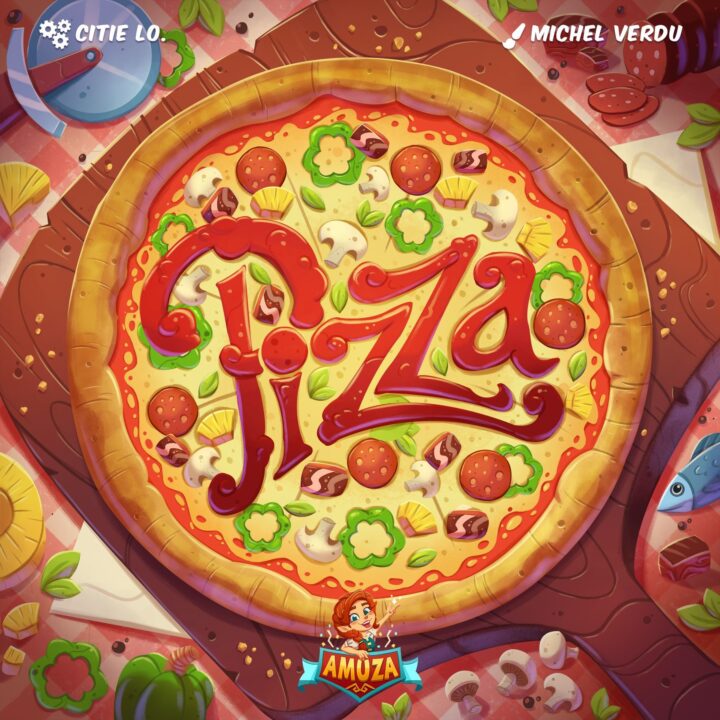I spent last weekend tossing fake pepperoni and arguing about imaginary anchovies, so yes, it’s time for my honest review of the board game ‘Pizza.’ It’s all about making the tastiest pizza, outsmarting friends, and watching your plans go up in smoke thanks to a bad card draw. If you’re hungry for laughs and a game that doesn’t take itself too seriously, grab a slice (of the action, not the board—I learned that the hard way). Read on to find out if Pizza is a hot new favorite, or if it left me as cold as leftover crust.
How It Plays
Setting up
Lay out the big pizza board in the middle. Everyone grabs a tiny pizza slice board. Shuffle the topping cards and deal everyone a hand. Place the rest in a draw pile—don’t eat them unless you want cardboard for dinner.
Gameplay
On your turn, draw a topping card and slap it on your slice if it fits the recipe. Or, throw some pepperoni at your friend’s board (not literally—unless you want crumbs everywhere). Players mess with each other by swapping or stealing toppings, trying to make their dream pizza before others do.
Winning the Game
The first person to finish their slice with the correct toppings yells “Order up!” and wins. Trust me, people yell louder when pizza is at stake. If the draw pile runs out, count up who has the most complete slice. Winner gets bragging rights until the next pizza night.
Want to know more? Read our extensive strategy guide for Pizza.
Game Mechanics and Player Interaction: The Heart and Cheese of Pizza
There’s something goofy about playing a game called pizza. I half expected a guy in a giant tomato costume to pop out with confetti and start shouting about mozzarella! But no, the board game pizza is all about speed and sneaky choices. The game goes fast, with everyone reaching for toppings and shouting out what they need. One round, my friend Tim tried to build a pineapple pizza. Big mistake. He got booed off the table. (We don’t mess around in my house.)
Mechanically, pizza is a recipe-completion game. You grab ingredient cards from a shared pool, trying to finish your pizza before everyone else. There’s a timer, so you can’t sit around overthinking your cheese-to-pepperoni ratio. The game puts pressure on you to make choices fast, which leads to lots of laughter and a few moments of panic. If your best friend swipes the mushroom card you need for your pizza, don’t worry—just shout at them with your mouth full of real pizza. That’s what I did. (Didn’t help, but it felt good.)
Player interaction is tasty in this game. You steal, you block, you trade. If you’ve got fast hands and a sharp eye, you’ll do well. But watch out: luck plays a pretty big part. Sometimes the cards go your way, sometimes they go in the oven. That makes winning feel a bit random but keeps the game light and funny. It’s not a deep strategy game, but it’s perfect for a party where no one is too serious about winning—or about cheese.
Now, let’s see if pizza looks as good as it tastes when we talk about component quality and artwork next. Stay hungry—I mean, tuned!
Component Quality and Artwork: Tasty or Tasteless?
The first thing that hit me when I opened the pizza board game box was the smell. Actually, that’s a lie—it did not smell like pizza, which was disappointing. But moving on, the real joy came from the chunky wooden pizza slices. These pieces are so satisfying to hold, I may have licked one. For science. The tokens shaped like pepperoni and bell peppers add a fun touch, and the quality is way better than those cheap plastic bits you find in bargain bin games. My friend Jon tried to stack five cheese tokens on his head, and they didn’t even break!
The board looks like a giant pizza, and yes, this means you’ll have a strong urge to order actual pizza. The colors pop, and the illustrations make me hungry every time. Every topping gets its own silly face. The anchovy token is my favorite—he looks so grumpy, just like my own face when I land on a bad slice. The cards feel thick enough to survive a greasy-fingered player or two, which in my group, is a must.
I do have to say, the box insert is weird. I don’t know who designed it, but my toppings roll all around the box when I put it away. You’ll probably want a few plastic bags or risk opening up a box of chaos next time.
Next up, let’s see if this pizza is just a one-night stand, or if it has the replay value of a good cold slice the morning after—get ready for Replayability and Game Length!
Does ‘Pizza’ Stay Fresh After Multiple Plays?
Alright, let’s answer the big question: will you want to play ‘Pizza’ again, or will it sit in your closet gathering dust next to that Monopoly set you regret buying? After more than a dozen playthroughs with my friends, I can say ‘Pizza’ serves up a good slice of replayability. The game gets everyone shouting about mushrooms versus pepperoni as if we’re rewriting the rules of Italian cuisine. Each round feels just different enough, thanks to the ever-changing toppings cards and special event twists. I even caught my friend Phil pretending he didn’t want anchovies just to mess with my strategy. Classic Phil.
Game length is another check in the ‘Pizza’ win column. On average, a session takes 30-40 minutes, which is just right. It’s not so short you feel cheated out of an experience, but not so long you start dreaming about actual pizza delivery. This sweet spot means you can easily squeeze in another round—or, if you’re like me, demand a rematch after losing to your little cousin who claims he’s a “pizza wizard.” And let’s be honest, nobody’s got time to spend two hours arguing about olives with Aunt Linda.
All in all, ‘Pizza’ does a solid job at keeping things lively and fresh. Sure, if you play it 50 times in a row, the novelty might cool off like leftover pizza, but mix up your group, and you’ll get plenty of flavor. Next up, let’s see if ‘Pizza’ nails the mark when it comes to the all-important battle between strategy and pure, maddening luck—because if I lose to Phil again on a coin flip, I’m eating the game board.
Strategy vs. Luck: Who Really Slices the Pizza?
Let’s talk strategy and luck—because this pizza game has both, and not always in the way you want. Once, my friend Lisa tried to outfox us with her secret pizza-building tactics. She studied the toppings, watched our every move, and made notes. Notes! In a pizza game! But in the end, her carefully-crafted plan went up in smoke. Why? Because she drew three onions in a row. That’s how luck gets you in this one.
Sure, you can plan your pizza for that perfect combo—say, three mushrooms and a rogue olive for the win. You can also try to guess what your friends have in their hand. Sometimes you even get to mess with them a bit, which is always fun. But at the end of the day, if the card gods give you nothing but anchovies, your plans are as useful as a pineapple on pizza (okay, I secretly like pineapple, but you get the idea).
Some say the chaos is what keeps the game fresh. It’s true—there’s never a dull moment. But if you love games where skill wins out over the shuffle of the deck, you may get frustrated like Lisa. I lost three times in a row once just because my topping draws were as unlucky as my haircut in third grade. Still, if you want to laugh, sabotage some friends, and see who ends up with a pizza only a mother could love, you’ll have fun.
So do I recommend this game? Yes, but only if you can stomach a big slice of randomness with your pizza. It’s not gourmet, but it sure is cheesy fun!
Conclusion
The pizza board game might not serve up the deepest strategy, but boy, does it deliver laughs and speedy fun. I love how easy it is to get started and how it keeps everyone talking and snatching for toppings. Sure, luck plays a big part—so my friend Greg won, and he’s usually banned from anything with dice. But if you want a light, silly time filler with tasty-looking pieces and tons of replay, this one’s worth a slice of your shelf space. That’s it for my review—now if you’ll excuse me, I’m off to eat a very real pizza. Stay cheesy!


